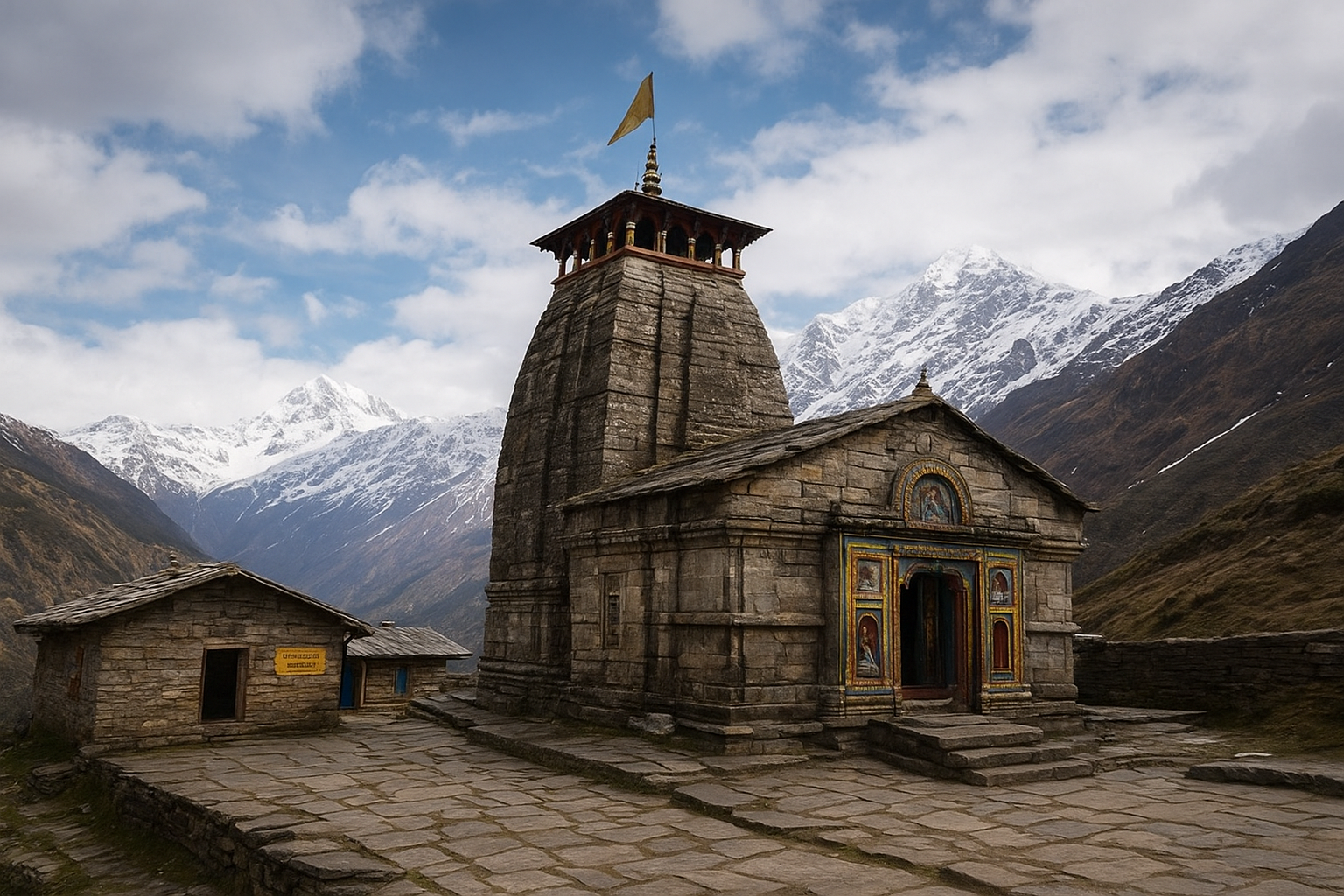The Historical and Spiritual Significance of Kedarnath Temple
The Kedarnath Temple, dedicated to Lord Shiva, holds profound historical and spiritual significance within Hinduism. Nestled in the Garhwal Himalayan range near the Mandakini River, the temple is not only a sacred site but also a marvel of ancient architecture. Its origins trace back to the era of the Mahabharata, where it is believed that the Pandavas sought Lord Shiva’s blessings to atone for their sins after the Kurukshetra war. The legend narrates that Lord Shiva, avoiding the Pandavas, took the form of a bull and disappeared into the ground, leaving his hump behind, which is now worshipped at the temple.
Kedarnath is also one of the twelve Jyotirlingas, which are considered to be the most sacred abodes of Lord Shiva. Each Jyotirlinga represents a unique manifestation of Shiva, and a pilgrimage to these sites is believed to bestow divine blessings and enlightenment. The temple’s mention in ancient texts and scriptures, such as the Skanda Purana, further emphasizes its revered status. Adi Shankaracharya, the 8th-century philosopher and theologian, is credited with the temple’s establishment in its current form. He played a pivotal role in reviving Hinduism and establishing the Char Dham Yatra, a sacred pilgrimage circuit that includes Kedarnath along with Badrinath, Gangotri, and Yamunotri.
The Kedarnath Temple stands as a testament to the deep-rooted spiritual heritage of Hinduism. Its significance extends beyond religious rituals to embody the essence of devotion, penance, and the pursuit of spiritual transcendence. The temple’s association with the Pandavas, its status as a Jyotirlinga, and its inclusion in the Char Dham Yatra underline its central role in Hindu mythology and religious practices. Pilgrims from all over the world visit Kedarnath to seek solace, spiritual fulfillment, and a connection to the divine.
Architectural Marvels and Natural Wonders Surrounding Kedarnath
Kedarnath Temple, a pinnacle of Hindu spiritual architecture, stands resiliently amidst the majestic Himalayas, a testament to human ingenuity and devotion. The temple’s construction is a marvel in itself, built from massive stone slabs intricately interlocked without the use of mortar. This robust method of construction has enabled the temple to withstand the test of time and the harsh climatic conditions of the high altitude.
The architectural design of Kedarnath Temple is captivating. It is adorned with intricate carvings that depict various deities, mythological scenes, and symbols significant to Hinduism. The stone walls of the temple are not merely structural elements but are canvases that narrate stories from ancient scriptures, reflecting the rich cultural heritage and religious fervor of the devotees. The garbhagriha, or sanctum sanctorum, houses the primary deity, Lord Shiva, in the form of a conical rock formation, which is venerated as one of the twelve Jyotirlingas.
Building such an architectural masterpiece at an elevation of 3,583 meters (11,755 feet) posed significant challenges. The severe weather conditions, including heavy snowfall and freezing temperatures, along with the remote location, demanded extraordinary efforts in terms of logistics and construction techniques. The temple’s endurance through natural calamities, including the catastrophic floods of 2013, underscores the resilience and divine aura associated with this sacred site.
Surrounding the Kedarnath Temple is an awe-inspiring landscape that enhances the spiritual experience for pilgrims. The temple is nestled within the Kedarnath range of the Himalayas, with snow-capped peaks providing a breathtaking backdrop. The pristine Mandakini River flows nearby, its clear waters adding to the serene ambiance. The natural beauty of the area, including lush green valleys, alpine meadows, and cascading waterfalls, complements the divine aura of the temple, making it a sanctuary of peace and tranquility.
Kedarnath’s unique blend of human craftsmanship and natural splendor creates an unparalleled setting for spiritual reflection and pilgrimage. It is this harmonious coexistence of architectural prowess and natural beauty that makes Kedarnath not only a significant religious site but also a mesmerizing destination for all who visit.
The Pilgrimage Experience: Journey and Rituals at Kedarnath
The pilgrimage to Kedarnath is a profound spiritual journey, drawing devotees from across the globe. Reaching this sacred site involves a combination of travel modes, starting from major cities like Delhi. Pilgrims often embark on their journey by taking a train or flight to Dehradun or Haridwar, followed by a road trip to Gaurikund, the base camp for the Kedarnath trek. From Gaurikund, the 16-kilometer trek to Kedarnath begins, offering breathtaking views of the Himalayan landscape. For those unable to trek, options like pony rides and palanquins are available, ensuring that everyone can experience this divine journey.
The trek from Gaurikund to Kedarnath is not only a test of physical endurance but also a spiritual cleanse. Along the path, pilgrims encounter numerous rest stops and tea stalls, providing refreshments and a chance to interact with fellow travelers. These interactions often lead to shared stories and personal anecdotes, fostering a sense of community among the pilgrims. The best times to visit Kedarnath are during the summer months, from May to June, and post-monsoon, from September to October. During these periods, the weather is relatively mild, and the pathways are accessible.
Upon reaching Kedarnath, pilgrims are greeted by the sight of the Kedarnath Temple, standing majestically against the backdrop of snow-capped peaks. The temple, dedicated to Lord Shiva, is a hub of various rituals and ceremonies. The day at Kedarnath begins with the morning aarti, a ritual that involves hymns and chants to awaken the deity. This is followed by the offering of flowers, milk, and other items by the devotees. The evening aarti, equally mesmerizing, marks the end of the day’s rituals, with the deity being put to rest amidst the chanting of mantras and lighting of lamps. The significance of these rituals lies in their ability to connect the devotees with the divine, offering a sense of peace and spiritual fulfillment.
Personal experiences of pilgrims add a unique dimension to the Kedarnath pilgrimage. Many recount moments of profound spiritual awakening and a deep sense of connection with the divine. These shared experiences highlight the transformative power of the Kedarnath pilgrimage, making it a journey not just of the body, but of the soul.
Kedarnath and the Legacy of Adi Shankaracharya
Adi Shankaracharya, the revered 8th-century philosopher and theologian, profoundly shaped the spiritual and cultural landscape of Kedarnath and Hinduism at large. Born in Kalady, Kerala, Shankaracharya embarked on a mission to revive and unify Hindu philosophy through his teachings and writings. His significant contributions include the establishment of the Advaita Vedanta school of thought, which advocates the concept of non-dualism and the oneness of the soul with the Supreme Being.
Shankaracharya’s journey to Kedarnath is a cornerstone of his spiritual legacy. According to legend, after a life devoted to the propagation of Hindu philosophy, he attained samadhi (a state of intense concentration achieved through meditation) at Kedarnath. This sacred site is not only home to the ancient Kedarnath Temple but also to the samadhi mandir of Adi Shankaracharya, which stands as a testament to his enduring influence. Pilgrims visiting Kedarnath often pay their respects at this mandir, acknowledging his pivotal role in shaping Hindu spirituality.
One of Shankaracharya’s most notable achievements was the establishment of the Char Dham pilgrimage, which includes Kedarnath, Badrinath, Gangotri, and Yamunotri. This pilgrimage circuit is considered one of the holiest journeys in Hinduism, drawing millions of devotees each year. By founding this sacred route, Shankaracharya not only facilitated the spiritual journey of countless individuals but also reinforced the cultural and religious unity of India.
Adi Shankaracharya’s teachings continue to resonate through the ages, influencing modern Hindu thought and practice. His emphasis on knowledge, devotion, and righteousness has left a lasting legacy that transcends time. In Kedarnath, his presence is felt deeply, as pilgrims and scholars alike reflect on his contributions to Hindu philosophy and the spiritual heritage of India. Through his life and works, Adi Shankaracharya remains a guiding light for those seeking spiritual enlightenment and understanding.






Leave a Reply